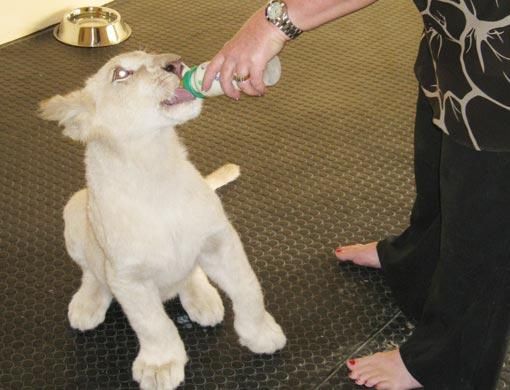Abu Dhabi: A third rare white lion from South Africa recently arrived at the Abu Dhabi Wildlife Centre (ADWC).
White lions are very valuable because they are so rare. It is thought there are only about 300 left.
Like many other African animals, lions are losing their habitat as human populations grow. There may be less than 21,000 African lions remaining in the wild. The remaining 300 white lions are all in captivity.
White lions don't survive well in the wild because their colour makes them stand out, unlike other lions which are well-camouflaged as they stalk their prey.
White lions get their colour from the chinchilla mutation, a recessive gene.
Transferred
The third white lion to be kept at the ADWC was transferred from a breeding centre in South Africa. There are two other white lions at the ADWC, a six- month-old male named Chance and an eight-month-old female who does not have a name yet.
The recent arrival is only four months old and feeds on cat formula milk and chunks of beef twice a day. Once a day the beef is laced with vitamins and calcium powder to help the cub stay healthy.
"When lions are three months old they start to chew on bones. Baby lions in captivity need to chew on rough food like lamb or goat skin to help develop their teeth. They also get lamb and goat liver regularly which is rich in vitamins and minerals," said Ronel Smuts, manager of ADWC.
The ADWC team hopes to breed more white lions.
"It's always preferable to keep white lions in captivity as they won't survive long in the wild because of their white colour," added Smuts.
Lions live in large family groups called prides. There are one or more mature males in each pride and a number of females with their cubs. The females, or lionesses, are the hunters while the males defend the group and their territory, explained Smuts.
An adult male can weigh as much as 180kg.
They have strong muscles in the chest and front legs which enable them to knock down and hold onto large animals. Powerful muscles and strong tendons in the rear legs let them leap very far.
The new cub at the ADWC is already so big and strong that he almost knocked Smuts down while playing with her during Gulf News' visit to the centre.
When lionesses hunt they split into two groups. One group will circle the prey. The second group will appear and frighten the animals. When they try to run away, they run straight into the first group who had circled them, explained Smuts.
Most of the hunting is done at night, therefore lions have superb hearing and eyesight. They can hear prey that is more than a kilometre away. Their eyes are the biggest of any meat-eating animal. Like the eyes of other cats, they are especially designed for seeing at night.
African lions prey on large herd animals such as wildebeests and zebras. If they can't find enough of their regular food, they eat smaller animals like hares and tortoises.
If prey is really scarce, lions will eat almost anything they can find, including snakes, insects and fruit.
To help lions sneak up on prey, they have rubbery pads on the bottom of their paws, which measures up to 12 centimetres, said Smuts. These pads help soften the sound of each step.
When they can, lions get their food by taking it away from other animals. This is often easier for them than hunting.
Although female lions do most of the hunting, the males eat first. When they're moving through tall grass, lions may not be able to see their prey but can always hear them.
"ADWC is entirely sponsored and supported by Shaikh Mansour Bin Zayed Al Nahyan, Minister of Presidential Affairs. This centre is only possible because of his love and devotion to wildlife which he inherited from the late president of the UAE, Shaikh Zayed Bin Sultan Al Nahyan," said Ali Jasem, chief advisor of the ADWC.
The ADWC would like school children to help choose names for the two white lions who remain unnamed. The female albino lioness is eight months old and the male lion is four months old.
80 schoolchildren to become volunteers
Abu Dhabi: More than 80 schoolchildren have asked to volunteer at the Abu Dhabi Wild Life Centre (ADWC) after reading a Gulf News article about 11-year-old Lee Caplen, who wanted to get a friends organisation off the ground to encourage the conservation of wild animals.
Caplen's mission to gather support from schoolchildren for the ADWC has come true. Her choice to conserve wild animals was part of a fifth grade school project to help the centre raise funds and spread the idea of volunteer work.
"Children, parents and schools contacted me after the article to offer their help at the centre. I'm happy that there was a positive response," said Ronel Smuts, manager of the ADWC.
Smuts has devoted herself to making sure endangered animals in the centre get the best possible treatment.
She is preparing for the opening of a new wildlife centre, which should be open by the end of the year.
Once the new ADWC is operational, Smuts will need many volunteers to help prepare food for the animals and with other tasks.
"Children are the conservationists of tomorrow. That's what this project is about. I encourage as much awareness as possible," said Smuts.














